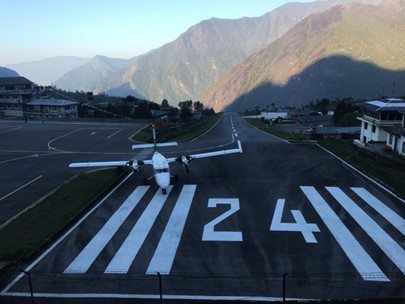
In a significant stride toward enhancing safety in Nepal’s aviation sector, the Civil Aviation Authority of Nepal (CAAN), in partnership with the National Innovation Center, has recently installed an en-route weather camera in the northeast region of Phaplu within the Kathmandu-Lukla (Ktm-Lukla) flight sector.
This innovative initiative aims to further safeguard flight operations in the challenging terrain of Lukla Airport, often recognized as the world’s most dangerous airport. It is an integral part of a broader plan to deploy weather cameras in multiple sectors across the country.
The decision to introduce en-route weather cameras in the Lukla sector stems from a crucial need for improved weather monitoring and safety measures in one of the world’s most challenging and breathtaking flight destinations.
Lukla, often referred to as the gateway to Mount Everest, is a vital hub for trekkers and mountaineers embarking on their trek to Everest Base Camp and other Himalayan peaks. However, its unpredictable and rapidly changing weather patterns have posed considerable challenges to aviation operations.
The newly installed weather camera in the Phaplu region will provide real-time weather data and live visuals to flight operators, allowing for better decision-making and increased safety during flight operations.
This technology enables pilots and aviation authorities to monitor weather conditions, cloud cover, visibility, and other critical parameters crucial for safe navigation through the challenging terrain of the Everest region.
This development builds upon the success of similar en-route weather camera installations in the Jomsom-Pokhara (Jomsom-PKR) sector, where these cameras have proven instrumental in ensuring safe and efficient flight operations.
CAAN is actively working to replicate this success by preparing to install additional en-route weather cameras in other sectors across Nepal.
The collaborative effort between CAAN and the National Innovation Center signifies a commitment to improving aviation safety and ensuring the well-being of passengers, crew members, and trekkers traveling to the breathtaking landscapes of the Everest region.
The en-route weather cameras not only enhance safety but also contribute to the reliability and efficiency of flight services, particularly in regions with challenging weather conditions.
As these en-route weather cameras continue to be deployed across the country, they will undoubtedly play a pivotal role in fortifying Nepal’s reputation as a top-tier destination for adventure and exploration, all while prioritizing safety above all else.


Nice post. I learn something new and challenging on blogs I stumbleupon on a daily basis.
I think the admin of this site is really working hard for his website since here every stuff is quality based data.
I do not even understand how I ended up here but I assumed this publish used to be great
it’s awesome article. I look forward to the continuation.
I appreciate you sharing this blog.Really looking forward to read more. Really Great.
I appreciate you sharing this blog.Really looking forward to read more. Really Great.
It’s nice to see the best quality content from such sites.
You have noted very interesting details! ps decent web site.
Nice post. I learn something new and challenging on blogs I stumbleupon on a daily basis. newsmax android app
Good article with great ideas! Thank you for this important article. Thank you very much for this wonderful information.
You have noted very interesting details! ps decent web site.
I really like reading through a post that can make men and women think. Also thank you for allowing me to comment!
Nice post. I learn something totally new and challenging on websites
very informative articles or reviews at this time. Watch bbc.persian
Thank you for starting this up. This website is something that is needed on the internet someone with a little originality!
Great information shared.. really enjoyed reading this post thank you author for sharing this post .. appreciated
Awesome! Its genuinely remarkable post I have got much clear idea regarding from this post
For the reason that the admin of this site is working no uncertainty very quickly it will be renowned due to its quality contents.